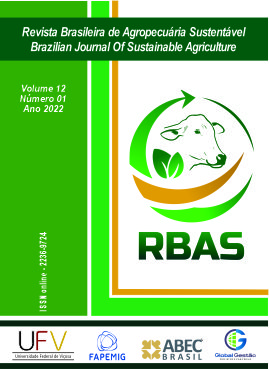ALTERNATIVE PRODUCTS POTENTIALITY FOR CERESPORAL SPOT CONTROL IN CHILI PEPPER GROWN IN SLOPE AREA
DOI:
https://doi.org/10.21206/rbas.v12i1.14508Keywords:
Cercospora capsici, Capsicum frutescens, plant disease control, alternative management.Abstract
In recent decades, more sustainable farming systems, that is, less dependent on the pesticides use, have been developed, in response to society demands for food with minimal natural resources degradation. Thus, the research has been testing several products, among which many have already been used by farmers in past decades.
The objective was to evaluate the alternative products effect on the Cercospora capsici control in pepper plants in a slope area. Capsicum frutescens plants were sprayed with Viçosa solution (1.5%), Bordalese solution (1.5%), sulfur-calcium solution (1%), sodium bicarbonate (0.2 M), neem oil (5%), raw milk (20%), methyl thiophanate (0.7 g/L) and water (control treatment). Severity, area under the disease progress curve (AUDPC), plant crown height and diameters, yield, length, diameter and mean fruit weight were determined. The Viçosa, Bordalesa and calcium sulphate solutions and raw milk, at the concentrations used, were efficient in reducing the brown eye spot severity in chili peppers cultivated in slope areas, did not cause toxicity to the environment, to the applicator and to the consumer, and thus, met to the pepper growers demands who seek to produce chili peppers in a sustainable way. The Bordalesa solution was the most promising, because in addition to the efficiency in controlling brown eye spot in chili pepper, it was easier to prepare and cheaper to obtain.
Downloads
Downloads
Published
How to Cite
Issue
Section
License
Copyright (c) 2022 Brazilian Journal of Sustainable Agriculture

This work is licensed under a Creative Commons Attribution-NonCommercial-NoDerivatives 4.0 International License.
1. Proposta de Política para Periódicos de Acesso Livre
Autores que publicam nesta revista concordam com os seguintes termos:
Autores mantém os direitos autorais e concedem à revista o direito de primeira publicação, com o trabalho simultaneamente licenciado sob a Licença Creative Commons Attribution que permite o compartilhamento do trabalho com reconhecimento da autoria e publicação inicial nesta revista.












